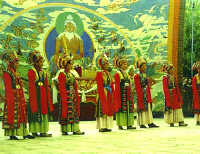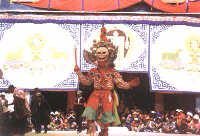| Art Q&A > Opera |
|
|
Tibetan Opera -- 'Living Fossil' of Tibetan Culture
The Tibetan people have long cherished this important folk art, which has become a source of identity for them. It is said that wherever you find Tibetan people, you will find Tibetan Opera.
There is a beautiful legend about the Tibetan Opera in its present form. During the 14th century, a high-ranking monk and bridge builder named Drupthok Thangthong Gyalpo decided to build iron bridges across all of the major rivers in Tibet to improve transportation and facilitate pilgrimages.
Tibetan Opera became known in the local language as Ace Lhamo ("fairy sisters"), and Thangthong Gyalpo himself is considered as the father of Tibetan Opera. To honor the great founding father, a blessing of his statue always precedes each Lhamo and usually ends with the presentation of the hada (a strip of raw silk or linen used for ritual greetings) by the performers and audience members.
|
|||||||||
 |

 Tibetan people's 'fairy sisters'
Tibetan people's 'fairy sisters'
